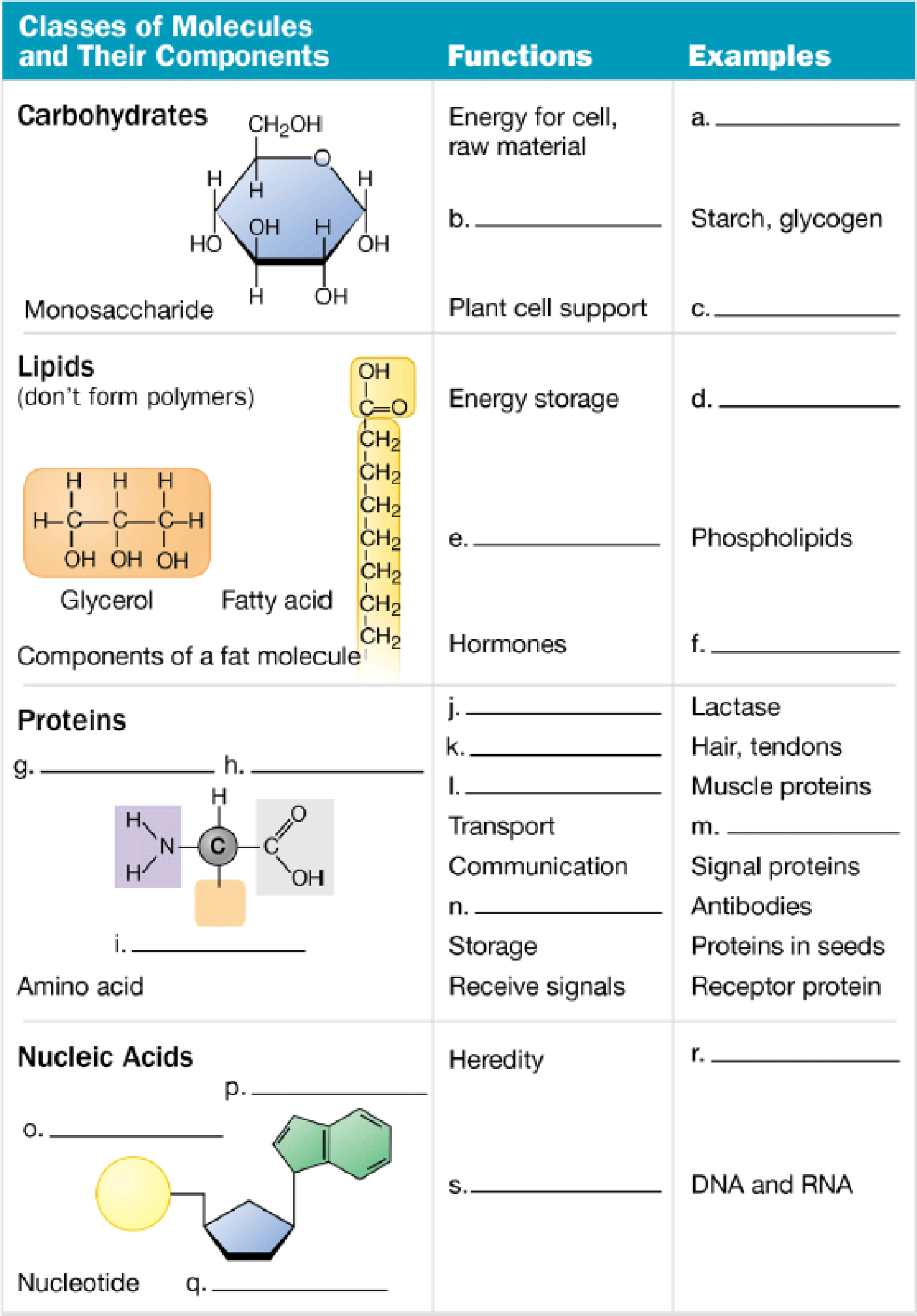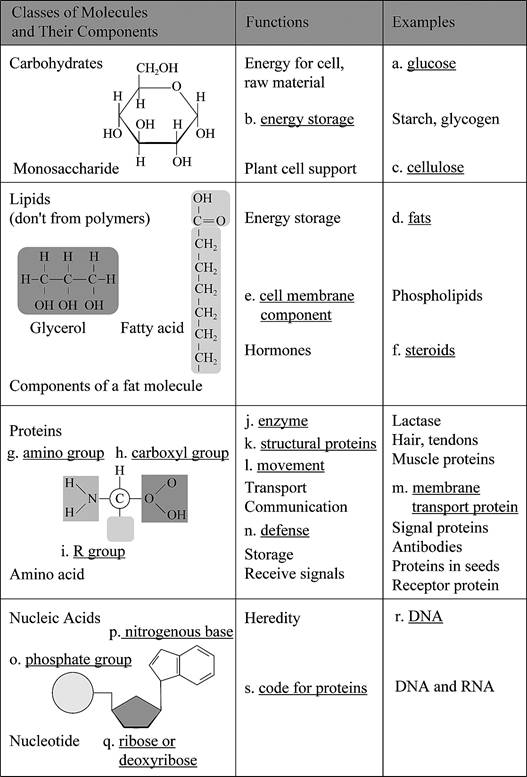
Concept explainers
Complete the following table to help you review the structures and functions of the four classes of organic molecules.

To create: The concept map to review the structures and functions of the four classes of organic molecules.
Introduction: The four classes of molecules such as carbohydrates, lipids, proteins, and nucleic acids are important to sustain the life. Carbohydrates serve as a fuel and building material for cellsand tissues. Lipid comprises a diverse group of molecules. It does not mix with water. A protein is a polymer of amino acids. It is structurally and functionally most complex and varied. Nucleic acid is the genetic material that consists of a polynucleotide.
Answer to Problem 1CC
Pictorial representation: Fig. 1 shows the completed concept map of structures and functions of the four classes of organic molecules.

Fig.1: Concept map of the structures and functions of the four classes of organic molecules.
Explanation of Solution
a.
Correct answer: Glucose
Explanation: Glucose is the raw material from which cell will get energy. Hence, the correct answer is Glucose.
b.
Correct answer: Energy storage
Explanation: The starch and glycogen is used as storage material of energy. Hence, the correct answer is energy storage.
c.
Correct answer: Cellulose
Explanation: Cellulose is polysaccharides which is a polymer of glucose molecule. Hence, the correct answer is cellulose.
d.
Correct answer: Fats
Explanation: Fats are a type of lipid. It is composed of glycerol and fatty acids. Hence, the correct answer is fats.
e.
Correct answer: Cell membrane component
Explanation: Cell is the outermost boundary of animal cell. It is made of phospholipid bilayer. Hence, the correct answer is cell membrane component.
f.
Correct answer: Steroids
Explanation: Steroids are hormones such as estrogen. Hence, the correct answer is steroids.
g.
Correct answer: Amino group
Explanation: Protein is made of amino acids. An amino acid contains amino group which is
h.
Correct answer: Carboxylic group
Explanation: Protein is made of amino acids. An amino acid contains carboxylic group which is
i.
Correct answer: R group
Explanation: Protein is made of amino acids. An amino acid contains a side group which is called R group. Hence, the correct answer is R group.
j.
Correct answer: Enzyme
Explanation: Proteins have broad functions such as enzymes, structural proteins, transport, movement, defense, and storage. Lactase is an enzyme used for breakdown of lactose molecule. Hence, the correct answer is Enzyme.
k.
Correct answer: Structural proteins
Explanation: Proteins have broad functions such as enzymes, structural proteins, transport, movement, defense, and storage. Hair and tendons are structural proteins. Hence, the correct answer is structural proteins.
l.
Correct answer: Movement
Explanation: Muscle is a protein that helps in movement. Hence, the correct answer is movement.
m.
Correct answer: Membrane transport protein
Explanation: Membrane transport protein helps in transport of different molecules across the membrane. Hence, the correct answer is Membrane transport protein.
n.
Correct answer: Defense
Explanation: Signal protein helps in communication. Antibodies are immunoglobulin protein that helps in body defense. Hence, the correct answer is defense.
o.
Correct answer: Phosphate group
Explanation: Nucleic acid is a polymer of nucleotides. A nucleotide consists of phosphate group, sugar and nitrogenous base. Hence, the correct answer is phosphate group.
p.
Correct answer: Nitrogenous base
Explanation: Nucleic acid is a polymer of nucleotides. A nucleotide consists of phosphate group, sugar and nitrogenous base. Hence, the correct answer is nitrogenous base.
q.
Correct answer: Ribose or deoxyribose
Explanation: Nucleic acid is a polymer of nucleotides. A nucleotide consists of phosphate group, sugar (ribose or deoxyribose) and nitrogenous base. Hence, the correct answer is ribose or deoxyribose.
r.
Correct answer: DNA
Explanation: Nucleic acid is a polymer of nucleotides. DNA (deoxyribonucleic acid) is the hereditary material. Hence, the correct answer is DNA.
s.
Correct answer: Code for protein
Explanation: Nucleic acid is a polymer of nucleotides. DNA and RNA have information to code for protein. Hence, the correct answer is code for protein.
Want to see more full solutions like this?
Chapter 3 Solutions
CAMPBEL BIOLOGY:CONCEPTS & CONNECTIONS
- Biopharmaceutics and Pharmacokinetics:Two-Compartment Model Instant Absorption Questions Calculate these : a) B1, b) B2, c) hybrid rate constant (1) d) hybrid rate constant (2) e) t1/2,dist f) t1/2,elim g) k10 h) k12 i) k21 j) initial concentration (C0) k) central compartment volume (V1) l) steady-state volume (Vss) m) clearance (CL) AUC (0→10 min) using trapezoidal rule n) AUC (20→30 min) using trapezoidal rule o) AUCtail (AUC360→∞) p) total AUC (using short cut method) q) volume from AUC (VAUC)arrow_forwardUse the Henderson-Hasselbalch equation for a propanoic acid solution (CH₂CH₂CO₂H, pK₁ = 4.874) to calculate the quotient [A-]/[HA] at three different pH values. pH = 4.479 [A-] [HA] [A-] pH = 4.874 [HA] = pH = 5.220 [A-] = [HA]arrow_forwardIn order to establish the expiration date of perishable food, growth curve data must be collected. Once the microbial load is so high that it poses a hazard to human health, the food item is no longer considered safe (expired). Generally a load of x50,000 bacteria/gram is considered unsafe. Your task is to determine the microbial growth curves for MicroYo, a new brand of yogurt. The growth is determined by sampling the yogurt and growing the bacterial isolates in broth culture which is then serially diluted by a total of x10,000 and inoculated onto standard petri plates of nutrient agar. The following colony counts are measured: Time (days) MicroYo colony count# 1 1 4 1 12 2 16 20 4 7 What day should you recommend expiring the yogurt (the last possible date before the microbial load is unsafe). 12 4 20 16arrow_forward
- 9. Chicken combs in chickens is an example where you see interactions between genes. See potential genotypes and phenotypes below. Which genotype, when mated to a rose comb chicken, will produce progeny that are 50% walnut comb and 50% pea comb? walnut (RRPP) walnut (RrPP) pea (rrPP) walnut (RRPP) walnut (RrPp) pea (rrPp) rose rose single (RRPP) (Rrpp) (rrpp)arrow_forwardDescribe a compound light microscope and its importance in microbiology (2) examples of at least two microbes viewed under a compound light microscope and their general characteristics (note: the microbes you choose do not need to be the ones outlined in the above tutorial video) and (3) at least one source you used for the information included in your infographic.arrow_forwardPrice of visit Number of visits $700 0 $600 [1 $500 2 $400 3 $300 4 00000 The Table blow gives the demand curve for doctor visits for Elena. If the price of a doctor's visit is $600, and Elena does not have health insurance, she will visit the doctor times. If Elena obtains 50% coinsurance (the company pays 50% of the medical bill, Elena pays 50%), then Elena will visit the doctor times. 1; 2 0; 3 0; 2 1;4 2; 1arrow_forward
- P 200 150- 100 50 w/instrance/ w/insurance 2 100 Demand Assume that the white curve (labeled "Demand") represents an individual's true demand for this particular health care service. The coinsurance associated with insurance option 1 (in blue) is likely _. 0000 100% 25% 50% 0%arrow_forwardUse the figure below. Bob and Nancy have the same income and total utility.. willingness to pay for an insurance premium will be lower than because they are. risk- averse. Total utility Current utility Bob's utility Nancy's utility 0000 Bob; Nancy; less Nancy; Bob; less Nancy; Bob; more Bob; Nancy; more Current Income incomearrow_forwardConsider the figure below. Suppose the true price of a health care service is P1. Suppose further that the individual has obtained insurance that has a fixed copayment for this particular service. The copayment is represented by price P2. represents the quantity of the service the individual would consume without insurance. quantity of the service the individual would consume with the insurance. Health Care Service represents the P. P₂ a Q1;Q2 Q2; Q3 Q1; Q3 Q3; Q1 Q2; Q1 फ f Q ८ g d h Q3\D 7Q 00000arrow_forward
- The table shows the utility Jordan receives at various income levels, but they do not know what their income will be next year. There is a 15% chance their income will be $25,000, a 20% chance their income will be $35,000, and a 65% chance their income will be $45,000. We know that Jordan is Income $25,000 Utility 2,800 30,000 3,200 35,000 3,500 40,000 3,700 45,000 3,800 ☐ none of the above 0 000 risk taker (lover) because their marginal utility of income is increasing risk neutral because their marginal utility of income is constant risk averse because their marginal utility of income is decreasing risk neutral because their marginal utility of income is decreasingarrow_forwardOOOO a d+e d a+b+c Consider the figure below. Suppose the true price of a health care service is P1. Suppose further that the individual has obtained insurance that has a fixed copayment for this particular service. The copayment is represented by price P2. The social loss from moral hazard if the individual has copayment P2 is represented graphically by the area(s): Health Care Service P. a No 4 ८ e g Q2 Q3 Darrow_forwardOOO O The table shows the utility Jordan receives at various income levels, but they do not know what their income will be next year. There is a 15% chance their income will be $25,000, a 20% chance their income will be $35,000, and a 65% chance their income will be $45,000. We know that Jordan's expected income is. Their utility from their expected income is_ Income $25,000 Utility 2,800 30,000 3,200 35,000 3,500 40,000 3,700 45,000 3,800 $45,000; 3,800 $40,000; 3,700 $25,000; 2,800 $35,000; 3,500 $30,000; 3,200arrow_forward
 Biology Today and Tomorrow without Physiology (Mi...BiologyISBN:9781305117396Author:Cecie Starr, Christine Evers, Lisa StarrPublisher:Cengage Learning
Biology Today and Tomorrow without Physiology (Mi...BiologyISBN:9781305117396Author:Cecie Starr, Christine Evers, Lisa StarrPublisher:Cengage Learning Human Biology (MindTap Course List)BiologyISBN:9781305112100Author:Cecie Starr, Beverly McMillanPublisher:Cengage Learning
Human Biology (MindTap Course List)BiologyISBN:9781305112100Author:Cecie Starr, Beverly McMillanPublisher:Cengage Learning Concepts of BiologyBiologyISBN:9781938168116Author:Samantha Fowler, Rebecca Roush, James WisePublisher:OpenStax College
Concepts of BiologyBiologyISBN:9781938168116Author:Samantha Fowler, Rebecca Roush, James WisePublisher:OpenStax College Biology (MindTap Course List)BiologyISBN:9781337392938Author:Eldra Solomon, Charles Martin, Diana W. Martin, Linda R. BergPublisher:Cengage Learning
Biology (MindTap Course List)BiologyISBN:9781337392938Author:Eldra Solomon, Charles Martin, Diana W. Martin, Linda R. BergPublisher:Cengage Learning Anatomy & PhysiologyBiologyISBN:9781938168130Author:Kelly A. Young, James A. Wise, Peter DeSaix, Dean H. Kruse, Brandon Poe, Eddie Johnson, Jody E. Johnson, Oksana Korol, J. Gordon Betts, Mark WomblePublisher:OpenStax College
Anatomy & PhysiologyBiologyISBN:9781938168130Author:Kelly A. Young, James A. Wise, Peter DeSaix, Dean H. Kruse, Brandon Poe, Eddie Johnson, Jody E. Johnson, Oksana Korol, J. Gordon Betts, Mark WomblePublisher:OpenStax College





